Food Insecurity, Population Growth, Urbanization and Water Availability: The Role of Government Stability
Abstract
:1. Introduction
1.1. Food Security and Sustainable Development Goals (SDGs)
1.2. Research Gap
1.3. Why Did Researchers Conduct This Study on Pakistan?
2. Literature Review and Hypotheses Development
2.1. Food Insecurity and Urbanization
2.2. Food Insecurity and Population
2.3. Food Insecurity and Water Availability
2.4. Food Insecurity and Research and Development
2.5. Moderating Role of Government Stability
2.6. Theoretical Justification of the Study
3. Data and Methodology
4. Results
5. Discussion
6. Conclusions
6.1. Contribution and Findings
6.2. Policy Implication
Author Contributions
Funding
Institutional Review Board Statement
Informed Consent Statement
Data Availability Statement
Acknowledgments
Conflicts of Interest
References
- World Health Organization. The State of Food Security and Nutrition in the World 2018: Building Climate Resilience for Food Security and Nutrition; Food & Agriculture Organization: Rome, Italy, 2018. [Google Scholar]
- Unicef and World Health Organization. The State of Food Security and Nutrition in the World 2017: Building Resilience for Peace and Food Security; Food & Agriculture Organization: Rome, Italy, 2017. [Google Scholar]
- Battersby, J. MDGs to SDGs–new goals, same gaps: The continued absence of urban food security in the post-2015 global development agenda. Afr. Geogr. Rev. 2017, 36, 115–129. [Google Scholar] [CrossRef]
- Kendall, A.; Olson, C.M.; Frongillo, E.A., Jr. Relationship of hunger and food insecurity to food availability and consumption. J. Am. Diet. Assoc. 1996, 96, 1019–1024. [Google Scholar] [CrossRef]
- Lee, J.S.; Frongillo, E.A., Jr. Factors associated with food insecurity among US elderly persons: Importance of functional impairments. J. Gerontol. Ser. B Psychol. Sci. Soc. Sci. 2001, 56, S94–S99. [Google Scholar]
- Oluoko-Odingo, A.A. Vulnerability and adaptation to food insecurity and poverty in Kenya. Ann. Assoc. Am. Geogr. 2011, 101, 1–20. [Google Scholar] [CrossRef]
- Men, F.; Gundersen, C.; Urquia, M.L.; Tarasuk, V. Association between household food insecurity and mortality in Canada: A population-based retrospective cohort study. CMAJ 2020, 192, E53–E60. [Google Scholar] [CrossRef] [Green Version]
- Molotoks, A.; Smith, P.; Dawson, T.P. Impacts of land use, population, and climate change on global food security. Food Energy Secur. 2021, 10, e261. [Google Scholar] [CrossRef]
- Hall, C.; Dawson, T.P.; Macdiarmid, J.I.; Matthews, R.B.; Smith, P. The impact of population growth and climate change on food security in Africa: Looking ahead to 2050. Int. J. Agric. Sustain. 2017, 15, 124–135. [Google Scholar] [CrossRef] [Green Version]
- McNeill, K.; Macdonald, K.; Singh, A.; Binns, A.D. Food and water security: Analysis of integrated modeling platforms. Agric. Water Manag. 2017, 194, 100–112. [Google Scholar] [CrossRef]
- Tacoli, C. The Urbanization of Food Insecurity and Malnutrition; Sage: London, UK, 2019. [Google Scholar]
- Chen, A.; Partridge, M.D. When are cities engines of growth in China? Spread and backwash effects across the urban hierarchy. Reg. Stud. 2013, 47, 1313–1331. [Google Scholar] [CrossRef]
- Hovhannisyan, V.; Devadoss, S. Effects of urbanization on food demand in China. Empir. Econ. 2020, 58, 699–721. [Google Scholar] [CrossRef] [Green Version]
- Mahlknecht, J.; González-Bravo, R.; Loge, F.J. Water-energy-food security: A Nexus perspective of the current situation in Latin America and the Caribbean. Energy 2020, 194, 116824. [Google Scholar] [CrossRef]
- Wolde, Z.; Wei, W.; Kunpeng, W.; Ketema, H. Local community perceptions toward livelihood and water–energy–food nexus: A perspective on food security. Food Energy Secur. 2020, 9, e207. [Google Scholar] [CrossRef]
- Pahl-Wostl, C. Governance of the water-energy-food security nexus: A multi-level coordination challenge. Environ. Sci. Policy 2019, 92, 356–367. [Google Scholar] [CrossRef]
- Kirby, R.M.; Bartram, J.; Carr, R. Water in food production and processing: Quantity and quality concerns. Food Control. 2003, 14, 283–299. [Google Scholar] [CrossRef]
- Heisey, P.W. Agricultural Research and Development, Agricultural Productivity, and Food Security; United States Department of Agriculture: Washington, DC, USA, 2001.
- Conceição, P.; Levine, S.; Lipton, M.; Warren-Rodríguez, A. Toward a food secure future: Ensuring food security for sustainable human development in Sub-Saharan Africa. Food Policy 2016, 60, 1–9. [Google Scholar] [CrossRef]
- Qaim, M. Role of new plant breeding technologies for food security and sustainable agricultural development. Appl. Econ. Perspect. Policy 2020, 42, 129–150. [Google Scholar] [CrossRef]
- Mok, W.K.; Tan, Y.X.; Chen, W.N. Technology innovations for food security in Singapore: A case study of future food systems for an increasingly natural resource-scarce world. Trends Food Sci. Technol. 2020, 102, 155–168. [Google Scholar] [CrossRef] [PubMed]
- Qureshi, M.E.; Hanjra, M.A.; Ward, J. Impact of water scarcity in Australia on global food security in an era of climate change. Food Policy 2013, 38, 136–145. [Google Scholar] [CrossRef]
- Huesing, J.E.; Andres, D.; Braverman, M.P.; Burns, A.; Felsot, A.S.; Harrigan, G.G.; Hellmich, R.L.; Reynolds, A.; Shelton, A.M.; Jansen van Rijssen, W.; et al. Global adoption of genetically modified (GM) crops: Challenges for the public sector. J. Agric. Food Chem. 2016, 64, 394–402. [Google Scholar] [CrossRef] [Green Version]
- Ur Rehman, T.; Khan, M.U.; Tayyab, M.; Akram, M.W.; Faheem, M. Current status and overview of farm mechanization in Pakistan—A review. Agric. Eng. Int. CIGR J. 2016, 18, 83–93. [Google Scholar]
- Chen, J. Rapid urbanization in China: A real challenge to soil protection and food security. Catena 2007, 69, 1–15. [Google Scholar] [CrossRef]
- Matuschke, I. Rapid urbanization and food security: Using food density maps to identify future food security hotspots. In Proceedings of the International Association of Agricultural Economists, Beijing, China, 16–22 August 2009. [Google Scholar]
- Liu, L.; Xu, X.; Chen, X. Assessing the impact of urban expansion on potential crop yield in China during 1990–2010. Food Secur. 2015, 7, 33–43. [Google Scholar] [CrossRef] [Green Version]
- Shu, J.-L.; Chen, Q. Dynamic relationship between China's urbanization and the food security. J. Xi'an Univ. Financ. Econ. 2012, 23, 11–15. [Google Scholar]
- Bremner, J. Population and Food Security: Africa’s Challenge; Population Reference Bureau Policy Brief: Washington, DC, USA, 2012. [Google Scholar]
- Cook, J.T.; Black, M.; Chilton, M.; Cutts, D.; Ettinger de Cuba, S.; Heeren, T.C.; Rose-Jacobs, R.; Sandel, M.; Casey, P.H.; Coleman, S.; et al. Are food insecurity's health impacts underestimated in the US population? Marginal food security also predicts adverse health outcomes in young US children and mothers. Adv. Nutr. 2013, 4, 51–61. [Google Scholar] [CrossRef] [Green Version]
- Jiao, L. Water shortages loom as Northern China's aquifers are sucked dry. Am. Assoc. Adv. Sci. 2010, 328, 1462–1463. [Google Scholar] [CrossRef]
- Avgoustaki, D.D.; Xydis, G. Plant factories in the water-food-energy Nexus era: A systematic bibliographical review. Food Secur. 2020, 12, 253–268. [Google Scholar] [CrossRef]
- Drangert, J.-O. Urban water and food security in this century and beyond: Resource-smart cities and residents. Ambio 2021, 50, 679–692. [Google Scholar] [CrossRef]
- Gaffney, J.; Bing, J.; Byrne, P.F.; Cassman, K.G.; Ciampitti, I.; Delmer, D.; Habben, J.; Lafitte, H.R.; Lidstrom, U.E.; Porter, D.O.; et al. Science-based intensive agriculture: Sustainability, food security, and the role of technology. Glob. Food Secur. 2019, 23, 236. [Google Scholar] [CrossRef]
- Gundersen, C.; Ziliak, J.P. Food insecurity and health outcomes. Health Aff. 2015, 34, 1830–1839. [Google Scholar] [CrossRef] [Green Version]
- Pollard, C.M.; Booth, S. Food insecurity and hunger in rich countries—It is time for action against inequality. Int. J. Environ. Res. Public Health 2019, 16, 1804. [Google Scholar] [CrossRef] [Green Version]
- Bruzelius, C. Local government responses to EU citizens’ integration needs. J. Ethn. Migr. Stud. 2020, 45, 1–19. [Google Scholar] [CrossRef]
- Sen, A. Ingredients of famine analysis: Availability and entitlements. Q. J. Econ. 1981, 96, 433–464. [Google Scholar] [CrossRef]
- Scanlan, S.J. Food availability and access in lesser-industrialized societies: A test and interpretation of neo-Malthusian and technoecological theories. In Sociological Forum; Springer: Berlin/Heidelberg, Germany, 2001. [Google Scholar]
- Oladimeji, Y. Food production trend in Nigeria and Malthus theory of population: Empirical evidence from rice production. Niger. J. Agric. Food Environ. 2017, 13, 126–132. [Google Scholar]
- Yaro, J.A. Theorizing food insecurity: Building a livelihood vulnerability framework for researching food insecurity. Nor. Geogr. Tidsskr. Nor. J. Geogr. 2004, 58, 23–37. [Google Scholar] [CrossRef]
- Chilton, M.; Rose, D. A rights-based approach to food insecurity in the United States. Am. J. Public Health 2009, 99, 1203–1211. [Google Scholar] [CrossRef] [PubMed]
- Lundy, L.; McEvoy, L. What Constitutes a ‘Rights-Based’ Approach? Law Child. Stud. Curr. Leg. Issues 2012, 14, 75. [Google Scholar]
- Pérez-Escamilla, R.; Segall-Corrêa, A.M. Food insecurity measurement and indicators. Rev. Nutr. 2008, 21, 15s–26s. [Google Scholar] [CrossRef]
- Thadewald, T.; Büning, H. Jarque–Bera test and its competitors for testing normality–a power comparison. J. Appl. Stat. 2007, 34, 87–105. [Google Scholar] [CrossRef]
- Dickey, D.A.; Fuller, W.A. Distribution of the estimators for autoregressive time series with a unit root. J. Am. Stat. Assoc. 1979, 74, 427–431. [Google Scholar]
- Phillips, P.C.; Perron, P. Testing for a unit root in time series regression. Biometrika 1988, 75, 335–346. [Google Scholar] [CrossRef]
- Hutcheson, G.D.; Sofroniou, N. The Multivariate Social Scientist: Introductory Statistics Using Generalized Linear Models; Sage: Newcastle upon Tyne, UK, 1999. [Google Scholar]
- Van, D.T.B.; Bao, H.H.G. A Nonlinear Autoregressive Distributed Lag (NARDL) Analysis on the Determinants of Vietnam’s Stock Market. In International Econometric Conference of Vietnam; Springer: Berlin/Heidelberg, Germany, 2019. [Google Scholar]
- Pesaran, M.H.; Shin, Y.; Smith, R.J. Bounds testing approaches to the analysis of level relationships. J. Appl. Econom. 2001, 16, 289–326. [Google Scholar] [CrossRef]
- Chandio, A.A.; Yuansheng, J.; Magsi, H. Agricultural sub-sectors performance: An analysis of sector-wise share in agriculture GDP of Pakistan. Int. J. Econ. Financ. 2016, 8, 156–162. [Google Scholar] [CrossRef] [Green Version]
- Dorosh, P.A.; Dradri, S.; Haggblade, S. Regional trade, government policy and food security: Recent evidence from Zambia. Food Policy 2009, 34, 350–366. [Google Scholar] [CrossRef]
- De Araújo Palmeira, P.; de Mattos, R.A.; Salles-Costa, R. Food security governance promoted by national government at the local level: A case study in Brazil. Food Secur. 2020, 12, 591–606. [Google Scholar] [CrossRef]


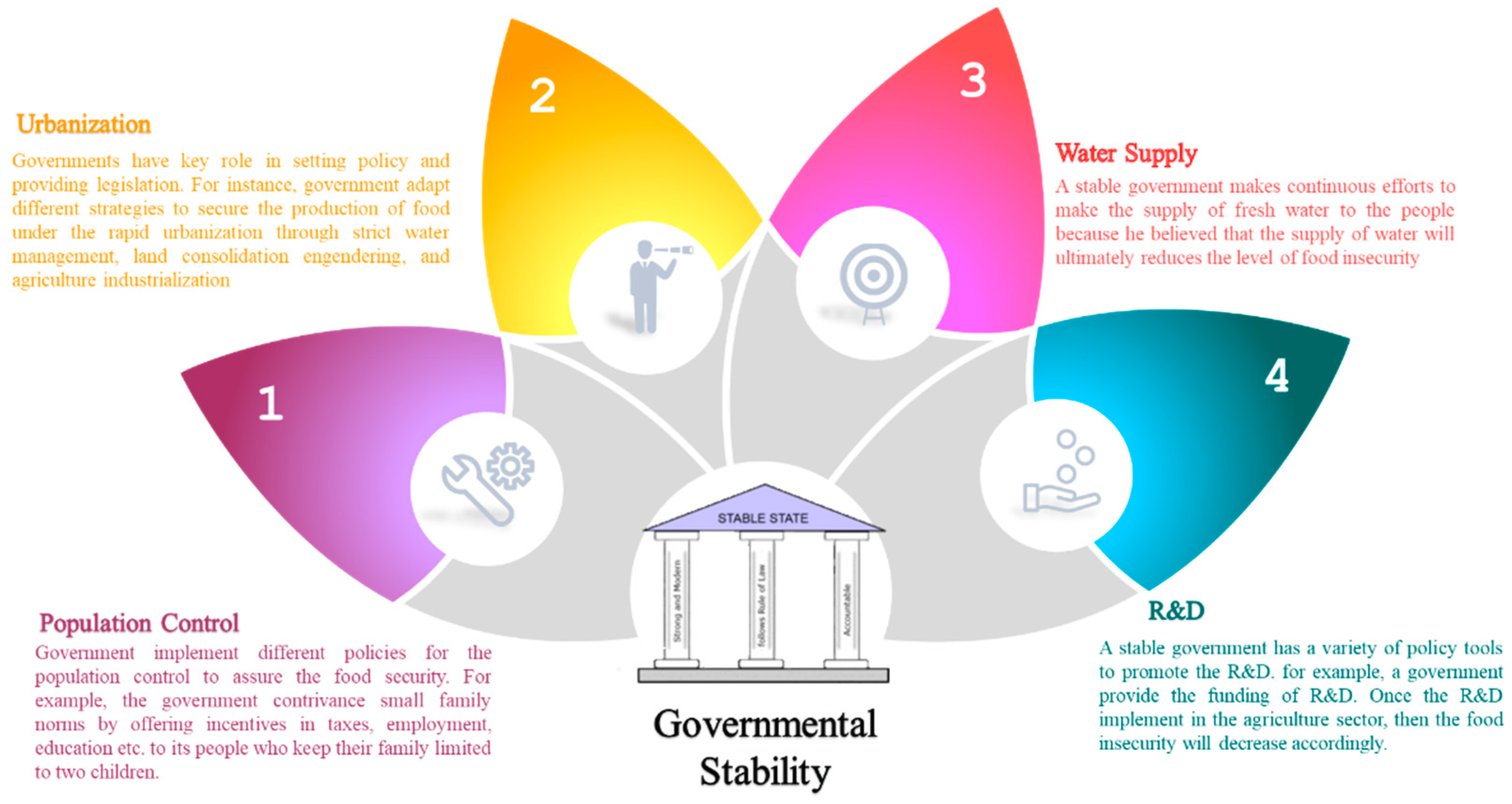
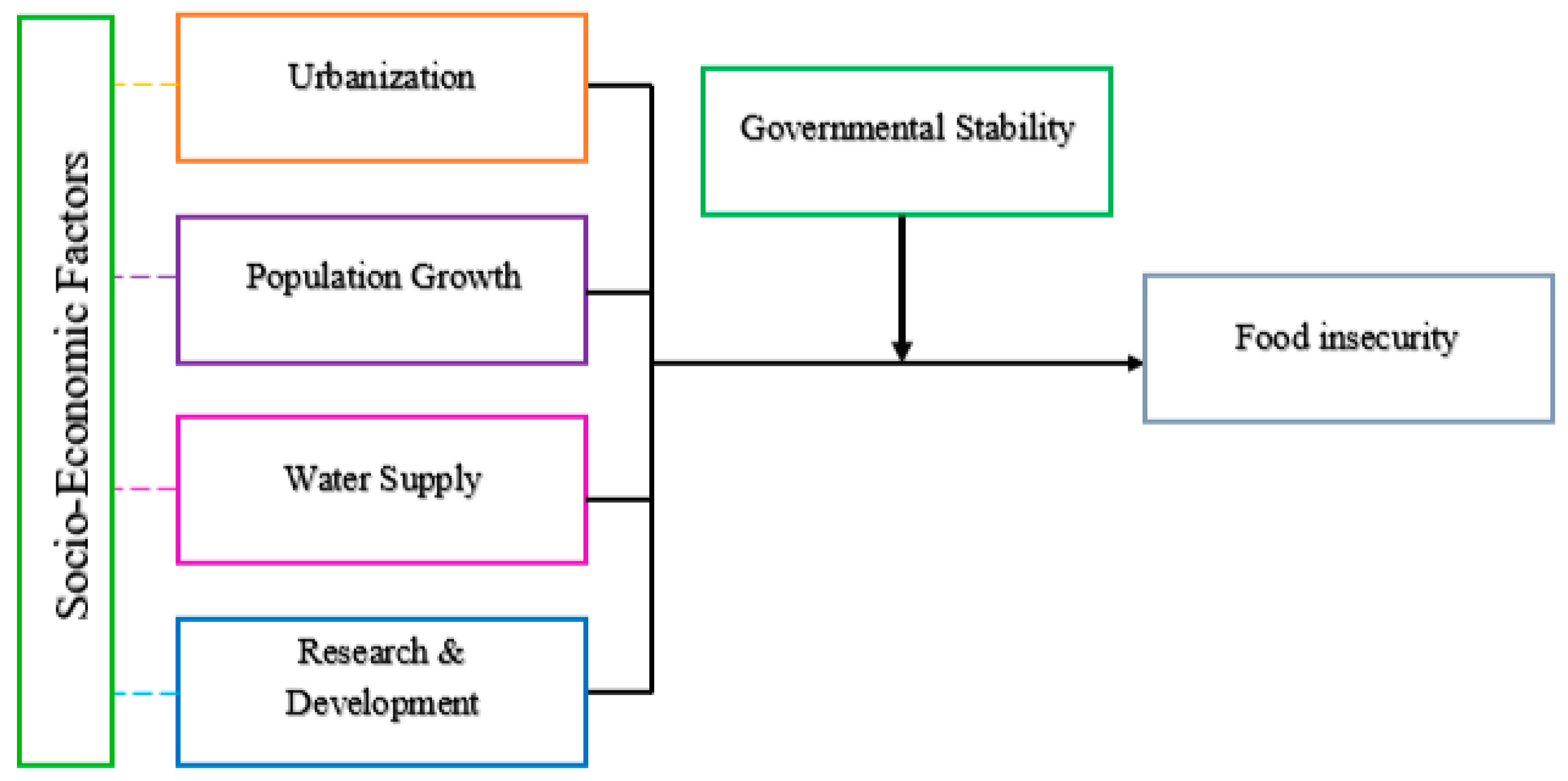
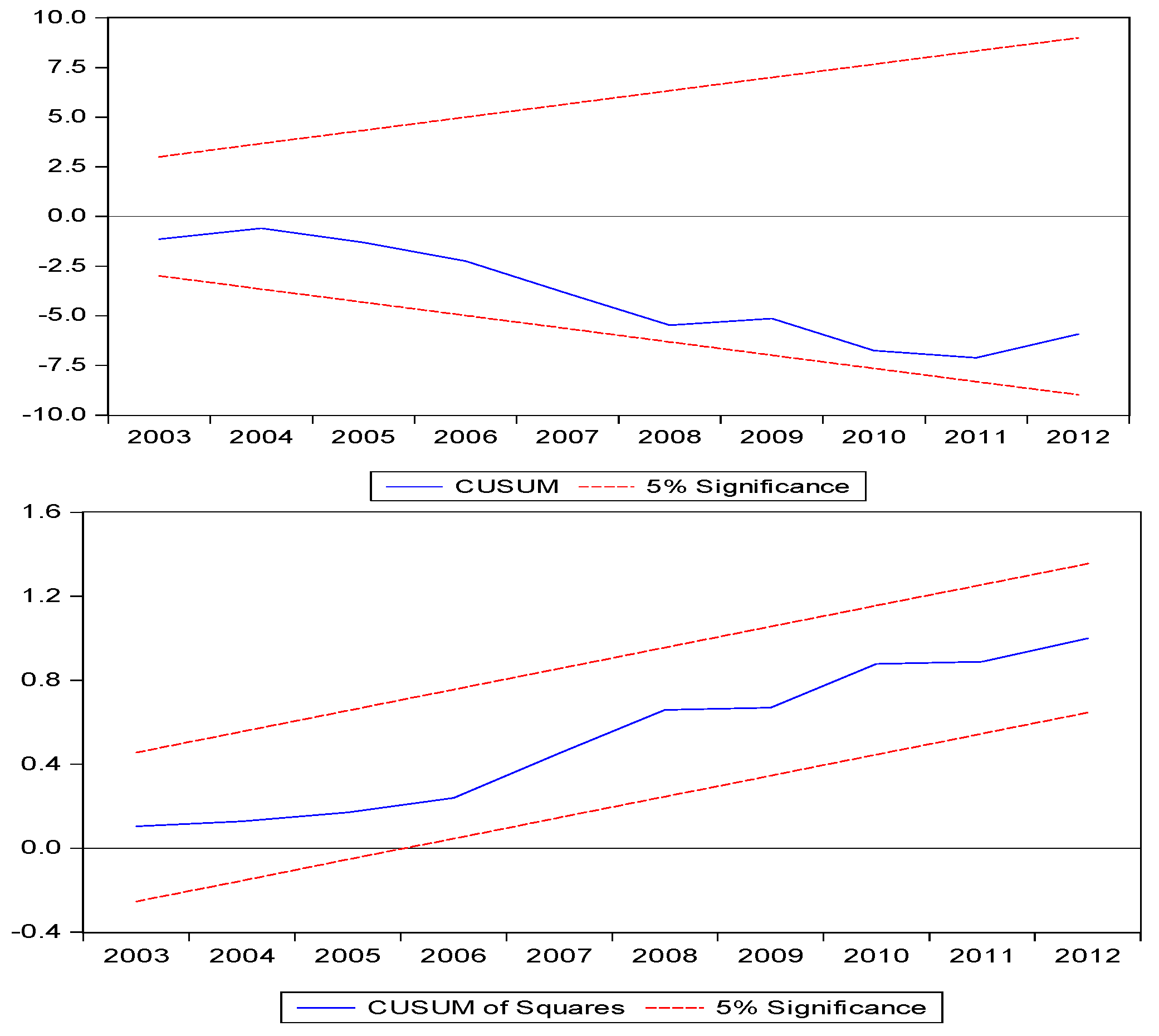

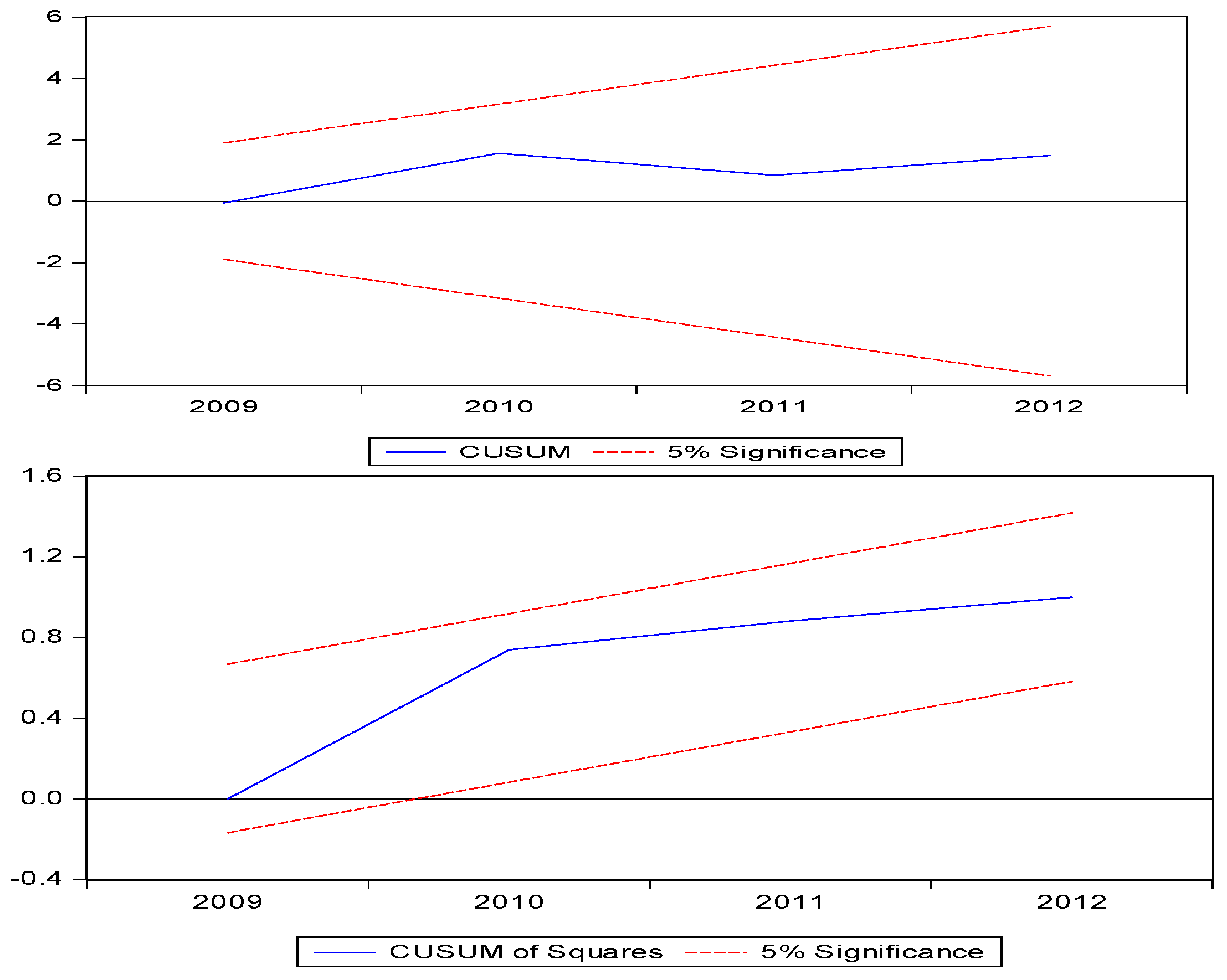
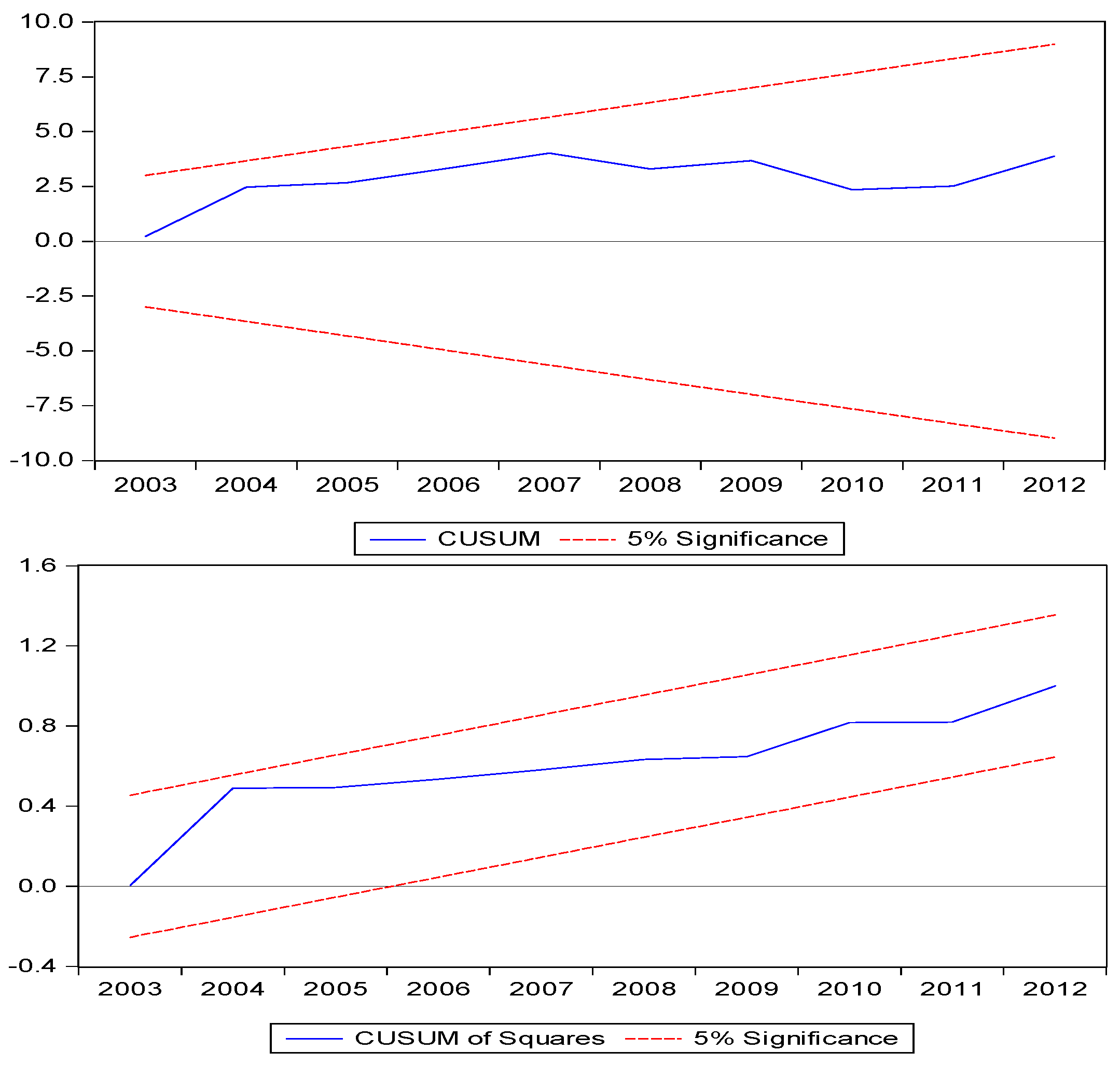
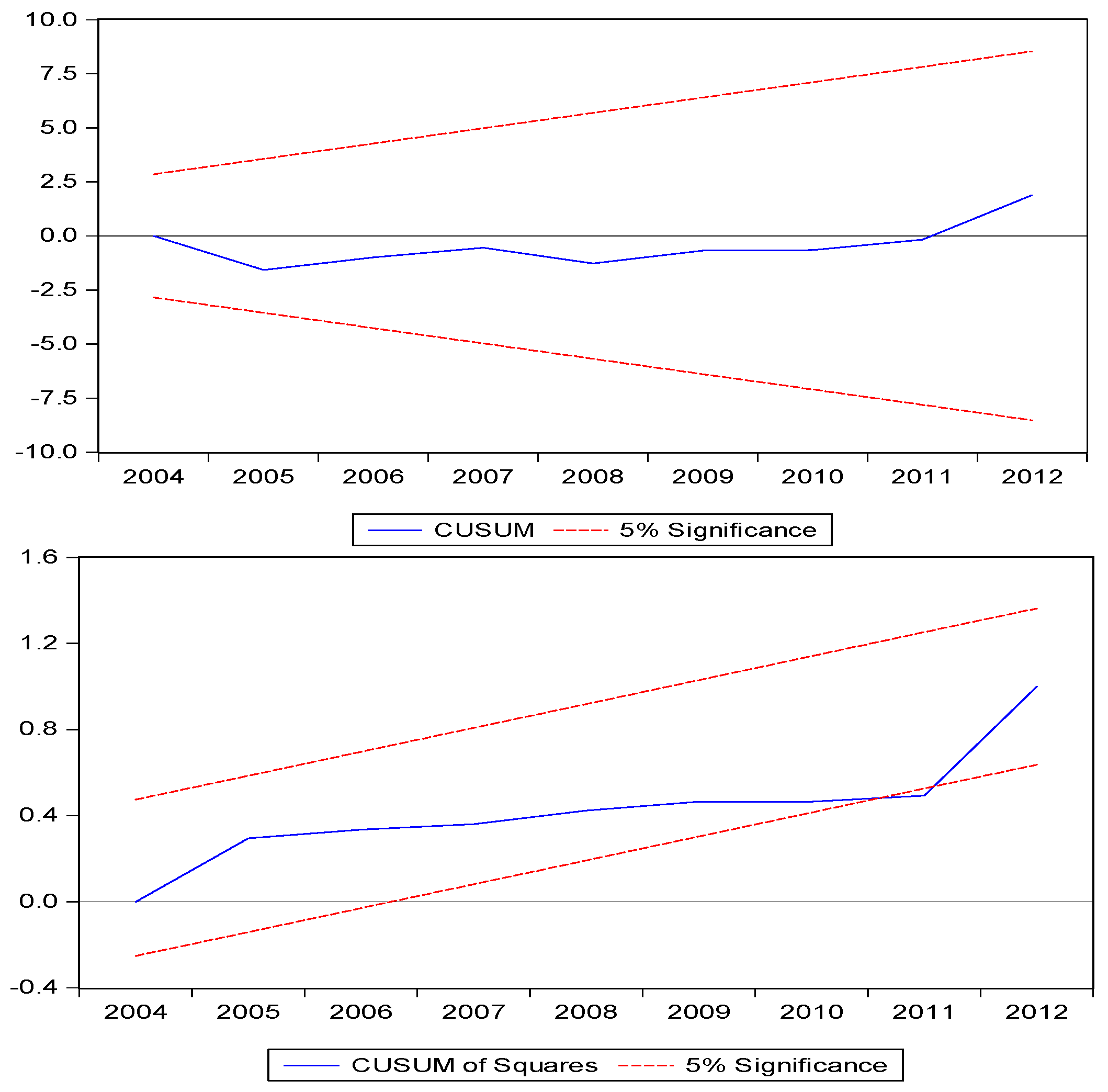
| Variable Name | Symbol | Variable Description | Data Source |
|---|---|---|---|
| Food Insecurity | Findex | Food availability + Food accessibility + Food stability | Food and Agriculture Organization |
| urbanization | Urb | The number of people who are living in urban areas | WDI |
| Population growth | POP | Population growth (annual %) | WDI |
| Agriculture Research | AST | Agriculture scientific techniques | FAO, AQUASTAT data. |
| Water Availability | WA | Annual freshwater withdrawals | WDI |
| Political Stability | PS | “Estimate of governance (ranges from approximately −2.5 (weak) to 2.5 (strong) governance performance)” | World Bank |
| WA | POP | URB | AST | FA | FS | FACC | FINDEX | PS | |
|---|---|---|---|---|---|---|---|---|---|
| Mean | 94.81 | 2.54 | 3.21 | 3456.8 | 104.35 | 2302.3 | 174.74 | −0.15 | −1.70 |
| Median | 94.26 | 2.52 | 3.12 | 3453.3 | 105 | 2321 | 171 | 0.0843 | −1.55 |
| Maximum | 96.79 | 2.96 | 3.77 | 3678.3 | 107 | 2360 | 187 | 1.04 | −1.1 |
| Minimum | 93.95 | 2.13 | 2.71 | 3338.4 | 101 | 2134 | 163 | −2.11 | −2.81 |
| Std. Dev. | 0.93 | 0.28 | 0.38 | 69.51 | 1.47 | 58.22 | 8.25 | 0.89 | 0.68 |
| Skewness | 0.87 | 0.00 | 0.13 | 1.24 | −0.54 | −1.30 | 0.31 | −0.55 | −0.52 |
| Kurtosis | 2.26 | 1.35 | 1.32 | 5.96 | 2.78 | 4.08 | 1.54 | 2.23 | 1.56 |
| Jarque-Bera | 3.45 | 2.62 | 2.76 | 14.31 | 1.14 | 7.54 | 2.40 | 1.71 | 3.03 |
| significance of Jarque-Bera statistics | 0.18 | 0.27 | 0.25 | 0.00 | 0.56 | 0.02 | 0.30 | 0.43 | 0.22 |
| Observations | 23 | 23 | 23 | 23 | 23 | 23 | 23 | 23 | 23 |
| WA | 1 | 0.798 | 0.857 | 0.008 | −0.686 | −0.681 | −0.738 | −0.816 | 0.698 |
| POP | 1 | 0.991 | −0.149 | −0.460 | −0.599 | −0.907 | −0.768 | 0.921 | |
| URB | 1 | −0.129 | −0.533 | −0.619 | −0.895 | −0.798 | 0.898 | ||
| AST | 1 | −0.062 | 0.037 | 0.124 | 0.041 | −0.141 | |||
| FA | 1 | 0.602 | 0.489 | 0.800 | −0.365 | ||||
| FS | 1 | 0.732 | 0.909 | −0.602 | |||||
| FACC | 1 | 0.868 | −0.950 | ||||||
| FINDEX | 1 | −0.752 | |||||||
| PS | 1 |
| Variables | Augmented Dickey-Fuller | Phillips-Perron | ||
|---|---|---|---|---|
| I(0) | I(1) | I(0) | I(1) | |
| WA | −6.901 * | −3.722 * | ||
| POP | −3.749 * | −1.122 | −5.451 * | |
| Urb | −1.273 | −4.992 * | −1.516 | −3.992 ** |
| AST | −1.978 | −4.300 * | −1.630 | −4.937 * |
| FS | −0.895 | −3.843 * | −1.324 | −9.452 * |
| FA | −0.725 | −4.322 * | −0.736 | −4.315 * |
| FACC | −1.175 | −3.235 * | −1.023 | −6.379 * |
| Findex | −1.160 | −4.736 * | −1.007 | −5.657 * |
| Principle Component Analysis | ||||
| Indicators | Factor Loadings | KMO | Bartlett’s Test of Sphericity | TVE |
| FA | 0.845 | 0.680 | 35.071 (0.000) | 78.721 |
| FS | 0.934 | |||
| FACC | 0.881 | |||
| Test Statistic | ARDL Bounds Test | ||||||||
|---|---|---|---|---|---|---|---|---|---|
| Model 1 | Model 2 | Model 3 | Model 4 | ||||||
| Value | k | Value | k | Value | k | Value | k | ||
| F-statistic | 8.907 | 4 | 7.929 | 6 | 11.352 | 6 | 9.513 | 6 | |
| Critical Values Bonds | Significance | I0 Bound | I1 Bound | I0 Bound | I1 Bound | ||||
| 10% | 2.45 | 3.52 | 2.12 | 3.23 | |||||
| 5% | 2.86 | 4.01 | 2.45 | 3.61 | |||||
| 2.5% | 3.25 | 4.49 | 2.75 | 3.99 | |||||
| 1% | 3.74 | 5.06 | 3.15 | 4.43 | |||||
| Dependent Variable: Food Insecurity | |||||
|---|---|---|---|---|---|
| Variable | Model 1 | Model 2 | Model 3 | Model 4 | Model 5 |
| D(WA) | −7.52 * [2.61] (−2.88) | −12.31 [12.10] (−1.02) | 0.73 [0.51] (1.43) | 0.60 [10.28] (0.06) | −4.526 * (2.003) [−2.260] |
| D(WA(-1)) | 0.97 [0.56] (1.72) | −1.13 [0.87] (−1.30) | −2.222 (1.970) [−1.128] | ||
| D(WA(-2)) | 1.839 * (0.508) [3.621] | ||||
| D(POP) | 39.35 * [14.63] (2.69) | 91.06 * [8.53] (10.67) | 79.93 * [7.62] (10.49) | 107.32 * [45.32] (2.37) | 6.355 * (2.833) [2.243] |
| D(POP(-1)) | 13.13 ** [6.68] (1.97) | 51.12 * [4.59] (11.14) | 49.15 * [4.78] (10.28) | 82.65 * [40.93] (2.02) | |
| D(URB) | 15.92 * [6.04] (2.64) | 23.39 * [3.10] (7.54) | −12.85 [14.73] (−0.87) | 20.92 * [7.03] (2.98) | |
| D(URB(-1)) | −41.71 * [12.51] (−3.33) | 9.12 [11.53] (0.79) | |||
| D(AST) | −0.06 * [0.01] (−6.00) | −0.02 * [0.01] (−2.60) | 0.00 [0.00] (0.44) | 0.00 [0.01] (0.60) | −0.002 ** (0.001) [−1.938] |
| D(AST(-1)) | 0.00 * [0.00] (2.94) | 0.01 [0.00] (1.49) | |||
| D(PS) | −34.06 * [14.76] (−2.31) | −34.06 * [14.76] (−2.31) | 0.10 [37.71] (0.00) | −0.709 (0.490) [−1.447] | |
| D(PS(-1)) | −46.66 * [10.93] (−4.27) | 21.48 [42.70] (0.50) | |||
| D(WA * PS) | 21.04 [24.16] (0.87) | ||||
| D(Urb * PS) | 69.98 [30.18] (2.32) | ||||
| D(Urb * PS(−1)) | 89.98 * [21.58] (4.17) | ||||
| D(pop * PS) | 6.87 [69.93] (0.10) | ||||
| D(pop * PS(-1)) | −43.44 [88.72] (−0.49) | ||||
| ECT | −0.81 * [0.25] (−3.22) | −0.98 * [0.12] (−8.05) | −0.90 * [0.12] (−7.20) | −.095 * [0.24] (−3.95) | −0.49 * (0.22) [−2.26] |
| Variable | Model 1 | Model 2 | Model 3 | Model 4 | Model 5 |
|---|---|---|---|---|---|
| WA | −1.98 ** [1.05] (−1.88) | −12.57 [12.22] (−1.03) | 0.81 (1.31) [0.62] | 1.52 [1.47] (1.03) | −1.64 * (0.30) [−5.44] |
| POP | 27.07 * [12.73] (2.13) | 41.54 * [7.50] (5.54) | 18.99 * (1.82) [10.44] | 87.45 (0.64) [135.97] | 1.54 (1.35) [1.14] |
| URB | 19.74 ** [10.29] (1.92) | 23.87 [4.83] (4.94) | 48.24 * (1.37) [35.15] | 6.15 [19.22] (0.32) | |
| AST | 0.10 * [0.02] (5.00) | −0.01 * [0.00] (−4.36) | 0.00 (−1.47) [0.00] | −0.01 [0.01] (−0.83) | 0.00 (0.00) [1.69] |
| PS | −8.87 * [2.27] (−3.90) | 45.43 * (1.30) [34.84] | −56.89 * [122.64] (−0.46) | −0.59 (0.34) [−1.75} | |
| WA * PS | 24.35 * [4.55] (5.35) | ||||
| Urb * PS | −84.63 * (−1.21) [69.86] | ||||
| POP * PS | 123.25 [244.27] (0.50) | ||||
| AST * PS | 43.54 * (26.55) [5.41] | ||||
| C | 189.88 [92.73] (2.05) | −36.12 (−0.67) [53.78] | −52.95 [108.58] (−0.49) | 25.34 (3.25) [7.79] | |
| R. Square | 0.83 | 0.95 | 0.98 | 0.59 | 0.92 |
| LM Test | 1.234 (0.33) | 3.497 (0.21) | 37.191 (0.118) | 4.127 (0.190) | 3.221 (0.09) |
| Breusch-Pagan-Godfrey | 0.851 (0.58) | 1.513 (0.28) | 3.225 (0.113) | 10.710 (0.236) | 2.11 (0.15) |
Publisher’s Note: MDPI stays neutral with regard to jurisdictional claims in published maps and institutional affiliations. |
© 2021 by the authors. Licensee MDPI, Basel, Switzerland. This article is an open access article distributed under the terms and conditions of the Creative Commons Attribution (CC BY) license (https://creativecommons.org/licenses/by/4.0/).
Share and Cite
Kousar, S.; Ahmed, F.; Pervaiz, A.; Bojnec, Š. Food Insecurity, Population Growth, Urbanization and Water Availability: The Role of Government Stability. Sustainability 2021, 13, 12336. https://doi.org/10.3390/su132212336
Kousar S, Ahmed F, Pervaiz A, Bojnec Š. Food Insecurity, Population Growth, Urbanization and Water Availability: The Role of Government Stability. Sustainability. 2021; 13(22):12336. https://doi.org/10.3390/su132212336
Chicago/Turabian StyleKousar, Shazia, Farhan Ahmed, Amber Pervaiz, and Štefan Bojnec. 2021. "Food Insecurity, Population Growth, Urbanization and Water Availability: The Role of Government Stability" Sustainability 13, no. 22: 12336. https://doi.org/10.3390/su132212336
APA StyleKousar, S., Ahmed, F., Pervaiz, A., & Bojnec, Š. (2021). Food Insecurity, Population Growth, Urbanization and Water Availability: The Role of Government Stability. Sustainability, 13(22), 12336. https://doi.org/10.3390/su132212336







